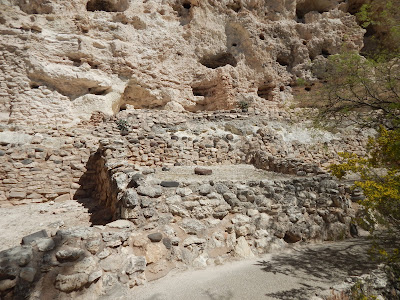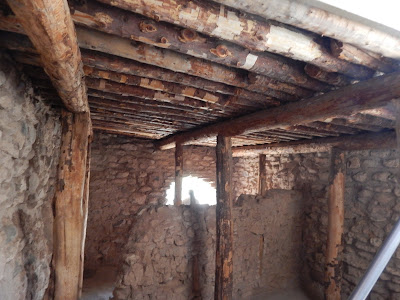So today we headed south again to the Verde Valley. We started at the casino again for breakfast, with it only be $10 each it is hard to beat. I particularly like the fact that they have Mexican Cotija cheese, which is strong, salty white cheese that you can sprinkle on anything. It is particularly good on eggs.
After breakfast we headed to the Montezuma Castle National Monument.
Southern Sinagua farmers built this five-story 20 room dwelling sometime between 1100 and 1300. It occupies a cliff recess 100 feet above the valley. Early settlers marveled at the structure and assume that is was Aztec in origin, hence the name Montezuma Castle. Now Bradley deteriorated it was once an imposing five-story apartment like building with about 45 rooms.
This diorama was built in 1955 to show people what the inside of the castle looked like. Originally they allowed people to go up inside the castle but there was too much damage being done to it so this was their alternative. Why would people build a home in a cliff face? They don’t really know for sure but they figured the proximity to water and farmland, stay above floods or for protection. Also the southern exposure that afforded winter solar heat and summer shade. A ready made shelter also meant fewer walls and roofs to construct for housing, storage, workspace, customs and rituals.
They organized and partitioned the space with walls from river cobbles and limestone held together with mud mortar. Mud plaster covered and sealed the walls. For roof beams and floors they used local sycamore that grew in the river valley as well they carried in fir and pine from a distance.
This is one of the sycamore trees that create a beautiful canopy in the area. It was like a little oasis. I thought that the bark was very interesting.
Each group living in the Castle likely had their own room, with roughly 140 square fee. Ceilings were about 5 feet and peep holes and doorways provided light in the morning and early afternoon, but rooms were dark from late afternoon on. Women and children likely did the plastering, including annual patching of exterior walls that eroded easily, their handprints are still visible in the plaster.
When the Sinagua left the area the dwelling was meant to recycle back to earth but when the area was made into a national monument in 1906 it was preserved for present and future generations.
When they excavated the area they discovered that there was other areas in the vicinity that were most likely used for other dwellings beside the main one. You can see where other rooms were made beside the castle. It looked like there was a vibrant neighbourhood.
Though the castle may seem remote, by 1300 it was a complex network of at least 40 Verde Valley villages. Between 6,000 and 8,000 people may have live in the valley and its surrounding uplands.
There are three monuments in this area, the second is Montezuma Well. It is a limestone sink that the Sinagua used to irrigate crops. There was about 100-150 people who lived around it. Unfortunately we were not able to visit is as there was an infestation of bees in the area so it was temporarily closed.
Our next stop was the Tuzigoot Monument.
Tuzigoot is an Apache word for crooked water. It is the remnant of a Southern Sinagua village built on a summit on a long ridge rising 120 feet above the Verde Valley. the original pueblo was two stories high with 87 ground floor rooms. There were very few exterior doors, entry to the rooms was done by ladders through roof openings. They think they went through the roofs because not having doors meant that they did not have to have hallways, which meant more space for rooms. Another reason was most likely kept out animals like mice and snakes. The last reason was most likely that it helped with insulation. The room on the top was restored to its original form and in the summer when the temperature outside is over 110 degrees, the room is like it has air conditioning.
Originally the area started out as a small cluster of rooms inhabited by about 50 people but by the 1200’s the population doubled and then doubled again.
This site was actually excavated from underneath a large pile of rubble. In 1932 many of Arizona’s copper mines closed and thousands were out of work. Nationwide unemployment was 15 million. the Tuzigoot excavation provided me and women much needed job during hard times. Local workers, with little or no experience learned to collect and preserve archeological material under the supervision of young archeology graduate students.
As they started to excavate, rooms started to emerge on top. Workers moved more than 5000 cubic yards of earth and 20,000 cubic yards of masonry.
On its rocky perch, Tuzigoot was flanked by farming areas with extensive field systems and shelters. As the village grew over the centuries a central plaza area emerged. The plaza enclosed by rooms made the villages more pueblo like. Sister villages may have formed on local hilltops when families split off from the main village. Living on hilltops, people had a line of sight between households and also by building where they did, no farmland was sacrificed and they avoided mosquitoes and floods living next to the river.
This is the river valley below.














No comments:
Post a Comment